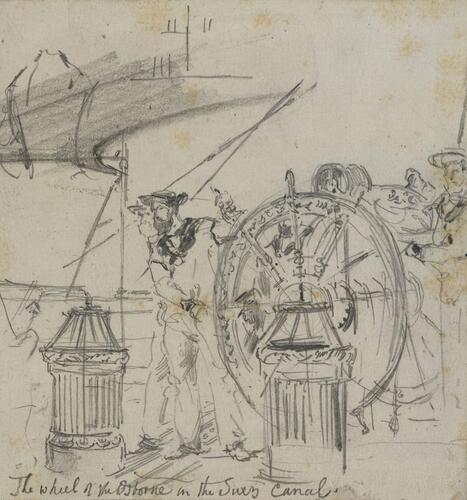Sydney Prior Hall (1842-1922)
Sailors at the wheel on HMY Osborne travelling down the Suez Canal c.1875
Pencil | 11.0 x 10.4 cm (whole object) | RCIN 931196
-
A pencil study depicting sailors at the wheel of HMY Osborne in the Suez Canal. Inscribed by the artist at bottom left: The wheel of the Osborne in the Suez Canal.
In October 1875, Albert Edward, the eldest son of Queen Victoria and Prince Albert and later King Edward VII (r.1901-10), embarked on an extensive tour of the Indian subcontinent, travelling on HMS Serapis. The Prince of Wales visited more than 21 towns and cities across parts of modern-day India, Sri Lanka, Pakistan and Nepal before returning to England in May 1876. On 23 October 1875 the royal party went down the Suez Canal as far as Ismailia on board HMY Osborne at a specially permitted fast speed. The Suez Canal, which had opened in 1869, was of significant strategic interest to Britain as it offered a new and considerably shorter route to India, which this tour took advantage of. In July 1882 the British launched a naval bombardment of Alexandria and went on to seize the canal; after several smaller conflicts, the Battle of Tel-el-Kebir on 13 September 1882 resulted in the British taking power in Egypt, though ostensibly it continued to be an independent country ruled by the Khedive. Egypt became a British protectorate in 1914 and was then granted nominal independence by the British in 1922; the Republic of Egypt was declared in 1953.
Albert Edward’s tour of India was envisaged as a way of forging diplomatic links between the Indian rulers and the British Crown. The tour was extensively covered in the British press pictorially as well as in the form of descriptive accounts of the royal engagements undertaken by Albert Edward and the entertainments and activities he enjoyed. Though there were controversies before the tour began about its expense and purpose, ultimately from the British perspective it was considered successful and the prince received a warm reception in the places he visited. The response on the Indian subcontinent to Albert Edward's tour, and what it symbolised in terms of imperial rule and colonial relations, was more mixed.
Gift-giving was an important aspect of Indian diplomacy, and thus while on tour the prince exchanged gifts with the rulers he met. However, the monetary value of the gifts given by Albert Edward was not always commensurate with that of the objects presented to him. Some of the most significant Indian works of art in the Royal Collection today were acquired during this tour. On his return to England, Albert Edward arranged for these to be exhibited to the wider public, first at the South Kensington Museum (now the Victoria & Albert Museum) and then at nine further venues across England, Scotland and Europe. In England and Scotland alone, more than 2.5 million visitors saw the Indian works of art.
Sydney Prior Hall was a draughtsman and illustrator who worked for the Graphic newspaper, as well as a portrait painter. He was invited to accompany the tour of India made by the Prince of Wales as Special Artist, and his watercolours of India were exhibited in 1876 at the South Kensington Museum along with some of the gifts given to Albert Edward. Many of the drawings Hall made during the tour were also reproduced as illustrations to The Prince of Wales's Tour. A Diary in India (1877) by William Russell, a reporter for The Times newspaper who travelled with the prince to India in the capacity of his Honourable Private Secretary. Sydney Prior Hall maintained a friendship with the prince after the tour, and Albert Edward often visited his studio in London.
This drawing is housed in one of three albums containing sketches relating to the Prince of Wales's tour in India.
Provenance
Acquired by King Edward VII when Albert Edward, Prince of Wales
-
Medium and techniques
Pencil
Measurements
11.0 x 10.4 cm (whole object)
Other number(s)
RL 31196








